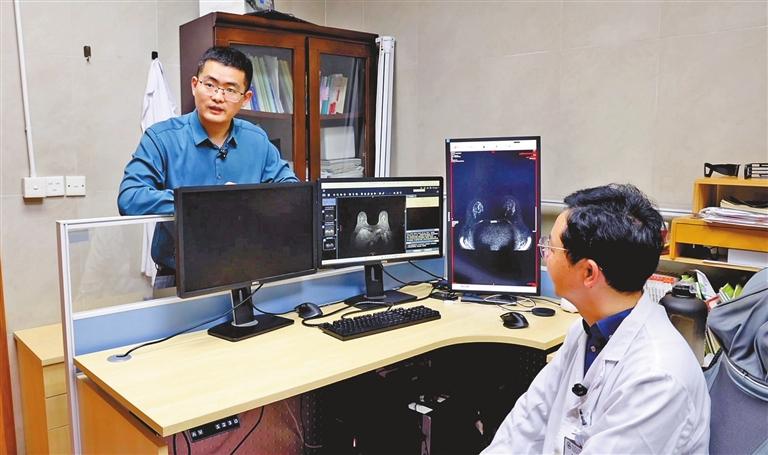
Chen Siqi vankochensq@163.com IN April, an article discussing the use of an artificial intelligence (AI) large model to improve breast cancer diagnosis using magnetic resonance imaging (MRI) data was published in Nature Communications, a leading scientific research journal. The study shows promising results: the AI-driven large model, called Mixture-of-Modality-Experts (MOME), could significantly boost radiologists’ efficiency in analyzing breast MRI scans — potentially easing the growing workload brought by China’s increasing breast cancer cases. AI helps tackle a major health threat to women The research was a collaborative effort among multiple institutions and hospitals. Shenzhen Daily recently interviewed two contributors: Prof. Chen Hao, assistant professor at the Hong Kong University of Science and Technology (HKUST), and Wu Mingxiang, chief physician of the Department of Radiology at Shenzhen People’s Hospital. “Breast cancer is a major threat to women’s health worldwide,” said Chen. “That motivated us to explore how AI can assist doctors in providing more precise breast cancer diagnosis and treatment.” According to the 2024 National Cancer Center Report, China recorded 357,200 new breast cancer cases in 2022, making it the second most common malignancy among women (with lung cancer rising to first place) and the fifth leading cause of cancer-related deaths. MRI is widely recognized as a highly sensitive and effective imaging technique for breast cancer detection, especially for high-risk patients. However, the rapid growth in breast cancer screenings has created a bottleneck: there aren’t enough radiologists to review all the data. Wu, a frontline radiologist, explained the challenge: “The number of radiological images has risen by 30% within a year in China, but the number of doctors has only increased by about 4.1%.” He added that interpreting complex multi-sequence MRI images is time-consuming. As the article showed, the MOME model was trained on breast MRI data from 5,205 patients across three hospitals in different regions of China. The model achieved an accuracy rate of over 90% in distinguishing benign from malignant tumors, which is comparable to the skill level of a radiologist with more than five years of experience, said Wu. “This is the world’s first multimodal large AI model designed specifically for reviewing breast cancer MRI data,” said Chen, assistant professor in the Department of Computer Science and Engineering and the Department of Chemical and Biological Engineering at HKUST. “It can achieve a non-invasive, pathology-level diagnosis, reduce patient suffering, and speed up clinical treatment.” Wu elaborated on how the large model works. The model can help doctors quickly browse through more than 1,000 MRI images, rapidly locate suspicious tumors, and determine whether they are benign or malignant. Hetao makes it possible In 2022, Shenzhen’s city government rolled out measures to support technological collaborations between Shenzhen and Hong Kong as well as Macao, enabling Chen and Wu’s teams to receive subsidies for their breast cancer research. Drawn by the geographical advantage and favorable policies of the Hetao Shenzhen-Hong Kong Science and Technology Innovation Cooperation Zone, Chen established a laboratory at the HKUST Shenzhen-Hong Kong Collaborative Innovation Research Institute, located in Hetao Shenzhen Park. The park is home to more than 220 research institutes and over 440 tech companies. “Hetao provides convenience for commuting between Shenzhen and Hong Kong and helps us access abundant resources in Shenzhen,” said Prof. Chen. “Shenzhen People’s Hospital’s rich clinical data and experienced doctors, combined with HKUST’s AI expertise, computing power, and engineering capabilities, have made this breakthrough possible. We are maximizing human-machine collaboration for patient benefit.” With the rapid advancement of AI, more AI-driven large models are expected to emerge in the healthcare fields. HKUST has already unveiled three other AI-driven models for medical applications. | 
